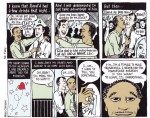A year after the first issue of Three, editor Robert Kirby is back for another helping of his artistic three-way, this time with six new cartoonists. If the first issue contained stories about a stranger in a strange land (or the feeling thereof), here it’s a bouquet of variations on romance gone awry.
First are British artist Sina Shamsavari (who signs “Sina Evil”) and Jon Macy, for a 9-page story entitled Dragon, where Mr Evil (doesn’t that sound like a C. C. Beck’s Captain Marvel villain?) writes, and Mr Macy draws. I don’t know how autobiographical this is, but the main character definitely looks like the writer. It’s a simple, effective and moving story: the protagonist meets an artist whose work he likes, fancies that classically good-looking guy, and after a short approach, they have some no-strings-attached sex. Nothing exceptional there. But the writing itself is precise and disconcerting: the main character is full of doubts, nicely represented by the title, which comes from an interpretation of the Chinese dragon (“It means you may or may no exist”) given by the cute artist, while the cute artist himself remains a mystery, as he’s only defined through the eyes of the main character. This means that we never quite know whether the cute artist is completely guileless or cleverly manipulative, and that keeps the reader on their toes. Macy’s art is equal to the task, with what for me is one of Macy’s strong points, his use of varied levels of realism in the representation of the characters. Look for example at the page I’m showing. After the first three panels drawn more or less in silhouettes on lots of solid blacks, the apparition of that realistic face full of emotions is all the more powerful. The eyes, especially, manage to convey the deep hunger felt by the character, a hunger for closeness and companionship that, combined with a certain naiveté, could have some undesirable consequences. But this isn’t a dramatic story, only a slice of a (gay) life, well told and well drawn.
The second story is a jam between Jennifer Camper and Michael Fahy, for Help Wanted, a wry look at a very queer romance. I don’t know whether this was a cadavre exquis or not, but it’s certainly a roller-coaster. The jam aspect comes from the way the story is told, with one artist drawing one row of the story, and then the other drawing the next. Their styles work surprisingly well together, considering Camper has a far rounder style than Fahy. The coherent coloring helps a lot, of course.
A couple of years ago, Leo fell for Raoul, who worked as his secretary. Raoul had a secret, but when he told Leo he was a FTM transexual, Leo didn’t run away screaming, and they began a relationship that’s only now threatened by the fact that Leo believes Raoul has an affair. Things get complicated when he calls his sister Lana for advice. Lana is a lesbian, who, years ago, had a fling with a Brazilian woman named LaRou…do you see where this is going? Well, no, you don’t, because in only 5 pages, Camper and Fahy pack more twists and turns than in a complete season of a mad soap.
I want to stress that the wild humor on display here is never at the expense of the characters. If anything, it helps highlighting the subversion of the usual codes of romance that drives the story.
Another take on romance can be seen in the third and longest story of this issue, with Craig Bostick and David Kelly giving us Nothin’ But Trouble. Bostick and Kelly have already collaborated for the Boy Trouble anthology, and this time, they each draw the pages narrated by one of the two main characters of the story (and there’s a different color too, just to make things clearer).
In this story set in the 50′s, Jimmy, a young cowboy singer, often feels lonely after the shows of his band. Then, one night, in one of the indistinguishable towns where they perform, he meets Butch, the picture of period handsomeness. They spend together a night of wild sex, and in the morning, Jimmy is hooked. But Butch doesn’t ask for his heart, only for his money. Jimmy has fallen in love with a hustler.
Bostick and Kelly have had the good idea of setting their story at a time when what could have been a stale cliché takes on a far more poignant aspect: Jimmy doesn’t have much choice in love, and his loneliness is clearly framed in the 50′s ambiance, socially and aesthetically speaking. The art of both Bostick and Kelly looks very old-school, and they’re used to working together, their pages showing open layouts that give a rhythm which is as unhurried as Help Wanted‘s was frantic. The two styles also retain their specificities, used to great effect to focus on each character and his point of view. I also liked that Butch isn’t demonized at all: he just seems to be as much adrift as Jimmy, though in a different way, since he’s shown as mostly in control of his own life. Nothin’ But Trouble is less sunny and light-hearted than its beginning would lead the reader to believe, but it manages to be open-ended without being happy-ended.
As you can see, this second issue of Three offers three collaborations done in three different ways, and proves, if need be, the vitality of the queer comics scene. Announced for the next issue are Ed Luce and his Wuvable Oafs, Carrie McNinch‘s autobio stories and a jam between alumni of queer anthologies such as Boy Trouble or Juicy Mother. I’ve heard about Luce’s comics, but I haven’t read them, and I hadn’t even heard of McNinch’s work, so I really look forward to that next issue.
You can buy this comic at Robert Kirby’s site, or from Last Gasp.





 Bluesky feed
Bluesky feed